America’s electric grid was born around 1882, when Thomas Edison showed the world his power plant in New York City. The underlying structure of our modern grid is largely the same as that of Edison’s initial feat, even though the number of users has grown from less than sixty in Edison’s day to hundreds of millions today.
The grid goes by many names: power grid, power distribution grid, electrical grid, and national grid. Its three main purposes are: to guarantee that energy is harnessed safely and effectively, to enhance our power supply capacity, and to make power system operations as efficiently and reliably as possible.
The Recipe for Energy
First, some form of energy is deployed to generate electricity. According to the United States Energy Information Administration, 60.8% of American electricity is generated by fossil fuels, 18.9% by nuclear, and 20.1% by renewables (hydro, wind, solar, biomass, and geothermal). Once the electricity is produced, it is transmitted across the country via transmission lines. It is then received by a local substation and finally allocated to homes, businesses, and other consumers in the area. See Figure 1 for a visual representation of electricity’s ‘factory line’.

Figure 1: Electricity lifecycle, from production to distribution.
As James McBride and Anshu Siripurapu write in The Council on Foreign Relations, “Taken together, the grid has been called the largest machine in the world, comprising eleven thousand power plants, three thousand utilities, and more than two million miles of power lines.”
Power plants transform energy sources such as coal, oil, wind, and hydro into electricity. Their productivity is measured in megawatts, where a watt is a measure of the amount of energy per unit of time. To give you a sense of magnitude, a typical coal-fired plant creates roughly 750 megawatts of electricity.
To turn a fuel source into electricity, many power plants employ turbine generators. A fluid, such as steam or exhaust from combustion, will cause the turbine blades to spin. A generator then converts the turbine’s mechanical energy into electricity (see Figure 2).

Figure 2: How energy flows from a power source to electricity consumers.
Not all electricity generators utilize turbines, the most prominent of which are solar photovoltaic (PV) systems and internal combustion engines. The former transforms sun rays into electricity without the ‘middleman’ of turbines. Solar photovoltaic ‘cells’ are conglomerated into panels that form the vast arrays of solar panels commonly shown by the media.
Challenges and the Future of the Grid
Unlike many other economic goods, electricity cannot be stored for future consumption–it must be used just after it is produced. This is why the grid must remain alert and adaptable to changes in electricity demand.
Although the grid’s infrastructure has not changed much in over a century, there are still exciting technological advancements underway. For example, the federal government is pouring money into a so-called Smart Grid, which “allows for two-way communication between the utility and its customers”. With the help of computers and automating software, transmission lines will be able to allocate electricity far more efficiently than ever before.
Benefits of the Smart Grid
The Smart Grid brings us numerous benefits. For example, it can automatically reroute power to an area in which a blackout has just occurred, drastically curbing the economic damage caused by power outages. Consumers of electricity also stand to gain from the Smart Grid, as they will be able to check electricity costs in real-time, rather than discover their costs only upon receiving their monthly bill. Thanks to ‘smart meters’, consumers can check the price of electricity continuously and decide how much of it to consume.
Concluding Thoughts
So long as storing electricity is an extremely costly endeavor, matching supply and demand will continue to be an issue with America’s energy grid. Fortunately, Bitcoin mining has emerged as the solution. For an in-depth discussion, see my previous articles on the subject.

1_3_22.jpg)